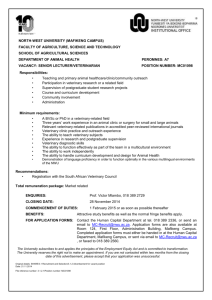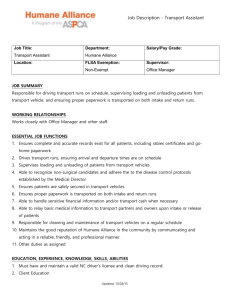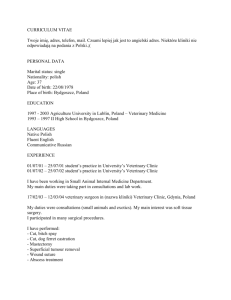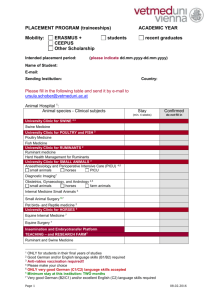Users of Veterinary Services * Chief Veterinarians and Vet Clinic Staff
advertisement
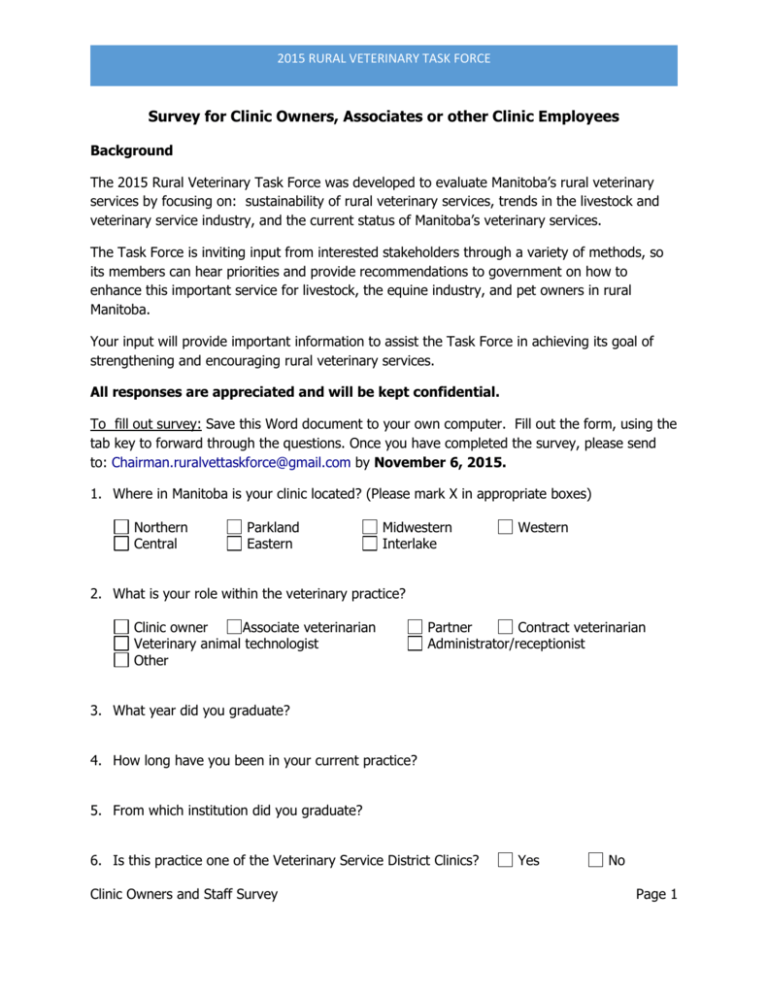
2015 RURAL VETERINARY TASK FORCE Survey for Clinic Owners, Associates or other Clinic Employees Background The 2015 Rural Veterinary Task Force was developed to evaluate Manitoba’s rural veterinary services by focusing on: sustainability of rural veterinary services, trends in the livestock and veterinary service industry, and the current status of Manitoba’s veterinary services. The Task Force is inviting input from interested stakeholders through a variety of methods, so its members can hear priorities and provide recommendations to government on how to enhance this important service for livestock, the equine industry, and pet owners in rural Manitoba. Your input will provide important information to assist the Task Force in achieving its goal of strengthening and encouraging rural veterinary services. All responses are appreciated and will be kept confidential. To fill out survey: Save this Word document to your own computer. Fill out the form, using the tab key to forward through the questions. Once you have completed the survey, please send to: Chairman.ruralvettaskforce@gmail.com by November 6, 2015. 1. Where in Manitoba is your clinic located? (Please mark X in appropriate boxes) Northern Central Parkland Eastern Midwestern Interlake Western 2. What is your role within the veterinary practice? Clinic owner Associate veterinarian Veterinary animal technologist Other Partner Contract veterinarian Administrator/receptionist 3. What year did you graduate? 4. How long have you been in your current practice? 5. From which institution did you graduate? 6. Is this practice one of the Veterinary Service District Clinics? Clinic Owners and Staff Survey Yes No Page 1 2015 RURAL VETERINARY TASK FORCE If you are comfortable doing so, please identify the district. 7. What is your definition of a rural veterinary practice? 8. What do you think are the main needs and wants of veterinary services clients in rural Manitoba? 9. How long do you plan to stay at this clinic? 10. How do you see the role and relevance of: The Veterinary Services Boards The Veterinary Services Commission The Veterinary Services Act 11. Why did you choose your current practice or career? (list as many reasons as come to mind): 12. What percentage of your billable hours come from: percentage Livestock Equine Companion animals don’t know Emergency Herd Health Speciality procedures, e.g. embryo transfer Emergency Animal Health Specialty Procedures Consulting re regulatory requirements Emergency Routine procedures Clinic Owners and Staff Survey Page 2 2015 RURAL VETERINARY TASK FORCE 13. What percentage of the clinic caseload is currently for the following animal types, and what percentage increase or decrease do you foresee for each of these animal types in the next 5 years? percentage clinic caseload percentage change in next 5 years Beef Dairy Swine Commercial horse Pleasure horse Sheep Goat Poultry meat Poultry Eggs Bison Farmed exotics Dogs, cats, exotic pets 14. Is the number of veterinarians in the clinic in proportion to the clinic caseload? Yes No 15. If you are the clinic owner or manager, do you have any challenges in attracting and retaining clinic staff? Yes No If yes, please explain: 16. What are the challenges or issues facing this practice? 17. What changes do you think could be made to make this clinic a better business? 18. What role do should the veterinary services have in the following areas? Rural economy Animal health Animal welfare Food safety Clinic Owners and Staff Survey Page 3 2015 RURAL VETERINARY TASK FORCE Biosecurity 19. Do you think the above issues play a role in mentorship of new veterinarians, technologists and /or other clinic employees? Yes No Please explain: 20. Are you active in any related public education workshops or programs? Yes No If yes, in what area(s): Customer advice/consultation Print resources Educational workshops Social media Other: Comments: 21. What changes do you see over the next five years in livestock production? 22. Do you see the veterinary services growing in your area? Yes No Why or why not? 23. What could be done to increase the number of qualified veterinarians (students or new Manitobans) working in rural areas? 24. Rural veterinary services receive support through government funding. In your opinion, how can this funding best be used? 25. What do you think is the ideal business model for a rural veterinary practice? Please consider things like: who should own a vet clinic; how should the veterinarian or other clinic employees be compensated; how much should the veterinarian or other clinic employees receive; what is the maximum geographical area that one clinic should serve; could a clinic form business alliances/partnerships with other vet clinics or other rural businesses; other. Clinic Owners and Staff Survey Page 4 2015 RURAL VETERINARY TASK FORCE Thank you for completing this survey – your input is valuable! A written submission can be sent to: 2015 Rural Veterinary Task Force Chairman 75 Christie Road Winnipeg MB R2N 4A4 (Chairman.ruralvettaskforce@gmail.com) You may also choose to participate in one of the fall Public Consultations held: October 20, 2015 in Dauphin, October 21, 2015 in Brandon, and October 22, 2015 in Stonewall. For further assistance, contact the 2015 Rural Task Force members directly at: Dr. Paul Schneider Chairman.ruralvettaskforce@gmail.com or 204-371-2573 Merv Starzyk, mcstarzyk@inetlink.ca Bertha Russell-Langan, B.Sc. counter@xplornet.com Clinic Owners and Staff Survey Page 5

